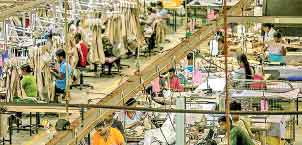Tuesday Apr 22, 2025
Tuesday Apr 22, 2025
Tuesday, 22 April 2025 01:40 - - {{hitsCtrl.values.hits}}
The economy of Sri Lanka is a mixed economy, valued at approximately Rs. 29.89 trillion (around $ 99 billion) in 2024 by gross domestic product (GDP), and estimated at $ 318 billion by purchasing power parity (PPP) in 2023. The nation’s economic landscape has been shaped significantly by external trade dynamics, and in light of recent US tariff policies, their potential impact on Sri Lankan exports and the labour market has to be studied.
 The economic growth of Sri Lanka has been uneven, largely affected by both global economic conditions and domestic political factors. Historically, the economy rebounded in the late 1990s, achieving average annual GDP growth of 5.2% from 1991 to 2000, but has faced multiple disruptions since then. Successive government have been and even the current are working on response strategies, which includes measures such as increasing taxes and implementing certain import restrictions to safeguard local industries and stabilise the economy.
The economic growth of Sri Lanka has been uneven, largely affected by both global economic conditions and domestic political factors. Historically, the economy rebounded in the late 1990s, achieving average annual GDP growth of 5.2% from 1991 to 2000, but has faced multiple disruptions since then. Successive government have been and even the current are working on response strategies, which includes measures such as increasing taxes and implementing certain import restrictions to safeguard local industries and stabilise the economy.
In 2024, Sri Lanka’s economy demonstrated a recovery, expanding by 5.0% following a severe economic crisis in 2022. However, the labour market faces challenges due to threats of rising factory closures and job losses, primarily attributed to a weakening Sri Lankan Rupee and fears over the possible removal of the European Union’s Generalised Scheme of Preferences Plus (GSP+) trade privileges. As a result, social uncertainty has been escalating, particularly in rural areas, where many individuals are seeking foreign employment opportunities as a means of escape, albeit with limited prospects abroad. The loss of skilled labour, however relatively a lower figure is a threat to the productivity of a country.
In this backdrop the Trump administration’s tariff increases on Sri Lankan exports poses significant challenges to the nation’s labour market, particularly within the critical apparel sector.
In 2024, Sri Lanka exported approximately $ 3 billion worth of goods to the US, with over 70% originating from apparel. The imposition of a 44% tariff on these exports threatens to render Sri Lankan garments uncompetitive in the US market, likely leading to decreased demand and financial strain on both large corporations and smaller exporters reliant on American consumers.
Cornerstone of Sri Lanka’s economy
The apparel industry is a cornerstone of Sri Lanka’s economy, directly employing around 300,000 individuals while supporting hundreds of thousands more through indirect employment. The looming threat of reduced profit margins may compel both larger companies and smaller, medium-sized exporters to cut production, implement layoffs, or even shut down operations entirely, exacerbating the economic challenges faced by the nation. With the apparel sector contributing to about 64% of our exports, valued at nearly $ 1.8 billion in 2023 and with nearly 40% of earnings coming from the US, decrease in revenue due to reduced orders could lead to mass layoffs across the sector, increasing employment concerns as industries scale down operations.
It is also noteworthy that Sri Lanka is not alone in facing increased tariffs; other major apparel-exporting countries such as Bangladesh, Vietnam, India, and Cambodia have also been subjected to high duties. However, Sri Lanka’s tariff rate stands out as one of the highest, placing it at a competitive disadvantage compared to these countries. As US buyers look to mitigate costs, though the widespread tariff increase complicates their ability to switch suppliers, they may switch to relatively low cost bases geographically further deepening the challenges for Sri Lanka’s export-driven economy. Furthermore the threat of increase in tariffs from GSP+ rates to MFN rates could lead to substantial export losses, ultimately affecting the livelihoods of many workers.
 |
| The apparel industry is a cornerstone of Sri Lanka’s economy, directly employing around 300,000 individuals |
The labour force in Sri Lanka already faces challenges, with the minimum wage for garment workers being dangerously low. The recent devaluation of the currency has further diminished workers’ purchasing power, resulting in increased financial strain on families. More downward pressure on wages, following several years of high inflation, could leave many workers with insufficient income, leading to dire consequences for those who manage to retain their jobs, including hunger and financial instability.
Moreover, the economic downturn could intensify existing worker abuses. As manufacturers strive to maintain their margins amidst rising costs for energy and materials, they may resort to cutting wages and reducing working conditions. This trend is particularly alarming if worker organising is suppressed and enforcement of basic standards is lacking, potentially leading to a decline in working conditions and rights. Worker organising conversely, if allowed can lead to losses in productivity only with little or no gain in a diminished export market.
In the long term, if the tariff increases lead to reduced demand for Sri Lankan exports, the ramifications for the labour market could be severe. There may be a significant decrease in formal job opportunities, particularly for women, who constitute a considerable part of the workforce in the garment industry. Furthermore, the pressure on foreign exchange reserves and the Government’s ability to support low-wage workers and their families could increase, leading to broader socio-economic calamity.
Furthermore, the weakening of the Sri Lankan Rupee, projected to fall further against USD, alongside fears over the removal of EU GSP+ trade privileges, is likely to exacerbate the economic challenges for the apparel sector. These factors contribute to rising poverty levels, and social unrest in rural areas, as individuals turn to foreign employment for better opportunities.
In the long term, if the tariff increases lead to reduced demand for Sri Lankan exports, the ramifications for the labour market could be severe. There may be a significant decrease in formal job opportunities, particularly for women, who constitute a considerable part of the workforce in the garment industry. Furthermore, the pressure on foreign exchange reserves and the Government’s ability to support low-wage workers and their families could increase, leading to broader socio-economic calamity
Compounding adverse effects
The Asian Development Bank (ADB) has preliminarily estimated that the global economic growth, including that of Sri Lanka, will be negatively affected due to the implementation of the proposed tariffs. In the light of these developments, the future labour market in Sri Lanka may experience increased volatility, with potential shifts in production locations as companies seek more favourable trading conditions elsewhere. Furthermore, the anticipated layoffs and economic slowdown could spill over into non-export sectors, compounding the adverse effects on domestic employment and overall economic stability.
The ramifications of this tariff extends beyond the apparel industry, potentially impacting other critical Sri Lankan exports, including rubber, coconut products, and tea sectors that are vital to the economy and employment.
In light of the increase in US tariffs, the Government is exploring several strategies to mitigate the potential adverse effects on the economy as a whole. Sri Lanka’s economic state following a recent financial crisis cannot bear the burden of these additional tariffs. Engaging in careful diplomacy and demonstrating our commitment to economic reform and bilateral reciprocracy or unilateral courtesy may bring relief or a waiver from the US. The 90-day pause is a god given opportunity to act fast and wise strategically.
In addition to diplomatic efforts, the Government has to be ready to provide domestic support measures aimed at affected industries. This has to include the introduction of policies to provide financial assistance and retraining programs for displaced workers. Such initiatives are essential to ensure that those who may lose their jobs due to tariff impacts are offered new opportunities within the labour market.
Economic experts and policymakers must urge the Government to explore the Generalised System of Preferences (GSP) scheme, which could offer tariff relief if the US extends this facility to Sri Lankan apparel products. This scheme is designed to support developing countries by reducing tariffs on exports to developed nations, thus enhancing trade competitiveness. If successful, this could alleviate some of the immediate financial pressures faced by Sri Lankan exporters and protect jobs in the apparel sector.
With increasing protectionist measures globally, particularly from the US, it is crucial for Sri Lanka to diversify its export portfolio and strengthen trade relations with regional partners such as India and East Asia. This shift could mitigate some negative effects of US tariffs, allowing for greater resilience in the labour market and overall economic stability.
The recent policy statement of the Prime Minister of Singapore in their parliament in response to “Trump Action” which triggered this article is a true reflection of national interest and economic wisdom with an approach of diplomacy in the face of adversity.
(The writer is a senior management professional and a human resource specialist with extensive industry exposure across multiple industries.)